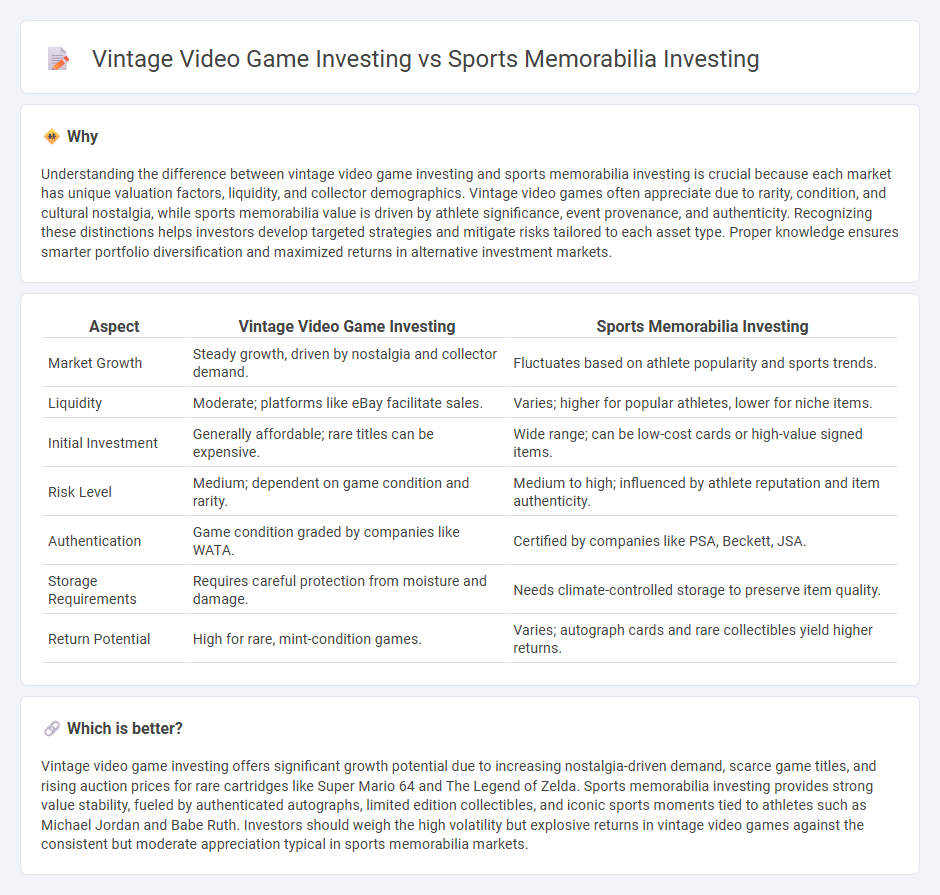
Vintage video game investing offers unique opportunities through rare cartridges and limited-edition consoles that appreciate due to nostalgia and rarity. Sports memorabilia investing relies heavily on authenticity, provenance, and the athlete's legacy, with items like signed jerseys and game-used equipment holding significant value. Explore the distinct advantages and risks of each asset class to diversify your investment portfolio effectively.
Why it is important
Understanding the difference between vintage video game investing and sports memorabilia investing is crucial because each market has unique valuation factors, liquidity, and collector demographics. Vintage video games often appreciate due to rarity, condition, and cultural nostalgia, while sports memorabilia value is driven by athlete significance, event provenance, and authenticity. Recognizing these distinctions helps investors develop targeted strategies and mitigate risks tailored to each asset type. Proper knowledge ensures smarter portfolio diversification and maximized returns in alternative investment markets.
Comparison Table
| Aspect | Vintage Video Game Investing | Sports Memorabilia Investing |
|---|---|---|
| Market Growth | Steady growth, driven by nostalgia and collector demand. | Fluctuates based on athlete popularity and sports trends. |
| Liquidity | Moderate; platforms like eBay facilitate sales. | Varies; higher for popular athletes, lower for niche items. |
| Initial Investment | Generally affordable; rare titles can be expensive. | Wide range; can be low-cost cards or high-value signed items. |
| Risk Level | Medium; dependent on game condition and rarity. | Medium to high; influenced by athlete reputation and item authenticity. |
| Authentication | Game condition graded by companies like WATA. | Certified by companies like PSA, Beckett, JSA. |
| Storage Requirements | Requires careful protection from moisture and damage. | Needs climate-controlled storage to preserve item quality. |
| Return Potential | High for rare, mint-condition games. | Varies; autograph cards and rare collectibles yield higher returns. |
Which is better?
Vintage video game investing offers significant growth potential due to increasing nostalgia-driven demand, scarce game titles, and rising auction prices for rare cartridges like Super Mario 64 and The Legend of Zelda. Sports memorabilia investing provides strong value stability, fueled by authenticated autographs, limited edition collectibles, and iconic sports moments tied to athletes such as Michael Jordan and Babe Ruth. Investors should weigh the high volatility but explosive returns in vintage video games against the consistent but moderate appreciation typical in sports memorabilia markets.
Connection
Vintage video game investing and sports memorabilia investing share a strong connection through their reliance on nostalgia-driven markets and collectible rarity, which drive demand and value appreciation. Both investment types benefit from passionate communities and limited supply, making provenance and condition critical factors in valuation. Market trends reveal increasing investor interest as these alternative asset classes diversify portfolios beyond traditional stocks and bonds.
Key Terms
Sports Memorabilia Investing:
Sports memorabilia investing offers access to high-value collectibles such as signed jerseys, game-used equipment, and rare trading cards, which have demonstrated consistent appreciation over time. The market is driven by athlete popularity, historical significance, and item provenance, making authenticated pieces highly sought after by collectors and investors alike. Explore more about strategic approaches and market trends in sports memorabilia investing to maximize returns.
Authentication
Authentication plays a critical role in sports memorabilia investing, with third-party grading services like PSA and Beckett ensuring the legitimacy and condition of items such as autographed jerseys and game-worn equipment. In vintage video game investing, authentication focuses on verifying original packaging, cartridge markings, and factory seals, often validated by companies like Wata Games to establish rarity and condition. Explore more about the nuances and best practices in authentication to maximize your investment returns.
Provenance
Provenance plays a critical role in sports memorabilia investing, as authenticated signatures, game-used equipment, and documented player history significantly increase an item's value and desirability. In vintage video game investing, provenance is established through original packaging, condition grading, and verified purchase history, which contribute to rarity and collector appeal. Discover more about how provenance impacts these unique investment markets and guides informed decision-making.
Source and External Links
How to Invest in Sports Memorabilia - Investing in authentic, historically significant sports memorabilia can diversify your portfolio and potentially yield high returns, as demonstrated by record sales of items like Babe Ruth's jersey and Mickey Mantle baseball cards, but requires careful research and sometimes financial advisor guidance.
Why You Should Invest In Sports Memorabilia - Strategic investment in rare and well-preserved memorabilia items such as autographs, game-worn jerseys, and trading cards can provide financial gains despite market volatility if supported by thorough research.
Sports - The sports memorabilia market, valued at over $15 billion annually, shows strong demand and appreciation for iconic items like Michael Jordan's signed sneakers and Kobe Bryant's hardwood pieces, making them attractive investments.
 dowidth.com
dowidth.com